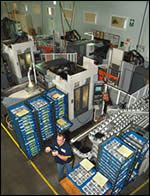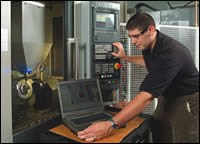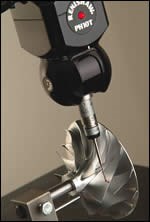CNCs Accomodate Various Automation Setups
As one Barrington, New Hampshire shop recently discovered, machining diesel engine turbocharger impellers from Type 2618 aluminum requires multiple passes to machine the blades.
Share




ECi Software Solutions, Inc.
Featured Content
View More
Takumi USA
Featured Content
View More

Hwacheon Machinery America, Inc.
Featured Content
View More.png;maxWidth=45)
DMG MORI - Cincinnati
Featured Content
View More
As one Barrington, New Hampshire shop recently discovered, machining diesel engine turbocharger impellers from Type 2618 aluminum requires multiple passes to machine the blades. Turbocam was able to not only successfully complete the job, but also reduce the run time by 20 percent. How did the company do it? To meet the requirements of this job and others, it relies on work cells that include five-axis machining centers equipped with flexible controls. These controls feature open architecture and specialized functions for an array of processes, including milling, drilling, turning, grinding and material handling.
Turbocam and its Turbocam Automated Production Systems (TAPS) division began with a single machine and a vision in 1985, says Rob Bujeaud, vice president of manufacturing for Turbocam. Early on, the company defined its vision—to offer its customers a complete turnkey package from engineering to application, software to machining programs, prototype to production runs, on a variety of complex parts.
Today, the company focuses its five-axis machining work on impellers, blades, blisks (bladed disks) and other mechanical components used in turbine engines, diesel engines, turbochargers and aerospace and power generation equipment. It also manufactures medical devices such as heart pumps. Turbocam processes a variety of aerospace, automotive and medical grade materials, including aluminum; magnesium; nickel-based alloys; titanium; 304, 416, 17-4 and 15-5 stainless; HP1318 surgical and various tool steels; and plexiglass impellers for the medical industry. The TAPS group carries out high-production runs, primarily aimed at the automotive sector, with similar work products.
In both of Turbocam’s facilities, which are located in Dover and Barrington, prototype and production work is performed on a variety of multi-axis machining centers and work cells created by the company’s engineering staff, which is headed by engineering manager Andrew Hussey. The Barrington facility houses TAPS, at the core of which are recently-installed work cells, each containing twin five-axis FZ08KSM machining centers from Chiron America, Inc. (Charlotte, North Carolina). These machines are fed by 250-capacity workpiece carousels and an ABB articulating robot. The work cells produce Type 2618 aluminum impellers for a diesel engine turbocharger.
According to Mr. Hussey, a large part of the success at TAPS can be traced to the speed, accuracy, control and automation of these work cells, driven by the Chiron machining centers.
“Aluminum stock is turned on CNC lathes and then loaded onto the carousels,” says Mr. Hussey. “The CNC onboard the machining centers, a Sinumerik 840D from Siemens (Elk Grove Village, Illinois) interfaces through our Profibus network to the robot controller and the carousel to maintain the workpiece load/unload cycles on the machines. Each robot handles two Chiron machines for virtually non-stop production, where the cells are programmed to run in fully unattended mode.”
The impellers machined on these work cells measure approximately 4 inches in diameter by 4 inches high; they load/unload at the rotary table fixture via robot. Many passes are required to produce the impeller blades. Therefore, the speeds of the spindle, the toolchanger and the rotary table are all critical for optimizing cycle times. The FZ08KSM machine used in this application offers a 2.3 square meter footprint, chip-to-chip time of 1.9 seconds or less, rapid feed rate of 75 m/min, acceleration to 2 g, typical spindle rate as fast as 27,000 rpm, tool changes in 0.8 seconds and, in this application, a two-axis NC rotary/tilt table. This is an ideal combination for the aluminum workpieces processed at TAPS, the company says.
Mr. Hussey and Mr. Bujeaud detail how a typical job flows through the TAPS engineering department: “We create our engineering model from the design data, such as a PRO-E model or an IGES file. It rarely happens that we get a machinable model from our customer, unless we’ve created it at our parent company (Turbocam). We analyze the customer model to determine the proper surface integrity and curvature to reduce surface deviation, designing the three-axis tool path, as well as the two-axis rotary table movements.”
Toolpath placement is the result of the company’s TruePath software from Ontario, Canada-based CAMplete Solutions and internal Turbocam coding. With this ‘clean data,’ Turbocam can determine the tool position and tool axis vectors in an APT format, with XYZ positions in 3D space. The approaches and retracts are automatically defined in the TruePath software, which saves time. The company reports that it is able to do the first runout on the actual production machine sooner than in the past, with more predictable results. In addition, Turbocam can simulate the execution of the program on different materials, using the company’s existing performance databases.
According to Mr. Hussey, there are advantages to using the CNC and drive package, Simodrive 611U, during this process: “The high speeds and five-axis movement can create non-linear machine motion that affects the accuracy of the cutting,” he explains. “The CNC/drive package helps to smooth out those kinematics. This is also an area where the CAMplete TruePath software compensates for non-linear machine motions.”
TruePath takes the APT or CL data as well as native CAM data such as MasterCAM .nci and OpenMind .pof and creates the CAM program, compensating tool path and communicating design intent in a manner comparable to a typical post-processor, with the added advantage of factoring the machine motions into the sequence. According to the developer, CAMplete Solutions, Inc., it provides everything necessary to modify, analyze, optimize, simulate and post-process five-axis tool paths in a virtually seamless five-view 3D environment. Toolpath editing, vectoring, vector modification to avoid collision and machine over travel monitoring can further reduce the time to first part.
Mr. Hussey comments that the reduction in run time exceeded 20 percent, compared to the production method and machines previously used for this particular application.
“We track the production on every machine in the facility and compare the output by machine—by cell and by product produced,” he says. “Because the materials we run vary considerably, and it is critical that we maintain these data to facilitate the proper selection of machines for target projects. In the case of these impellers, we knew the Chiron machines that we first saw at IMTS in 2004 and again at the 2005 EMO show were the answer.”
Despite the speeds involved, the company is typically able to reach tolerances that are better than ±0.002 inch. The vibration monitors, spindle accelerometers and laser position detectors onboard the machining centers further assist in maintaining the high accuracy on these complex milled parts, says the company. A custom washdown kit is installed on each machine, as the intricacies of the part necessitate elimination of chip migration essential for process integrity. The control with an onboard ePS network server also monitors tool wear and overall machine maintenance, with Wi-Fi email capability directly from the controller to Chiron America in North Carolina as well as the machine builder’s factory in Germany.
Regarding the overall operation of the machine controls, Mr. Hussey notes that its operators and application engineers like the speed and the flexibility of the Siemens CNC. The open architecture of the CNCs onboard the machining centers make them adaptable to changes, auxiliary equipment add-ons and the attendant monitoring/tracking of data required thereby. Mr. Hussey adds that the CNC has the ability to process data and remain flexible enough to accommodate the company’s various automation setups. Consequently, when using this technology concurrently with the Chiron machines, the company is able to achieve what it believes to be the optimal combination for this particular application.
The transformation orientation (TRAORI) feature of the 840D also affords the company greater control over the entire process, because it’s based on workpiece orientation rather than the tool position in a predetermined program. According to the company, this results in a more consistent finish and less chatter on the surface of the material, a critical factor when producing these turbocharger components.
Related Content
Investing in Automation, Five-Axis to Increase Production Capacity
To meet an increase in demand, this shop invested heavily in automation solutions and five-axis machines to ramp up its production capabilities.
Read MoreHow to Accelerate Robotic Deburring & Automated Material Removal
Pairing automation with air-driven motors that push cutting tool speeds up to 65,000 RPM with no duty cycle can dramatically improve throughput and improve finishing.
Read MoreLean Approach to Automated Machine Tending Delivers Quicker Paths to Success
Almost any shop can automate at least some of its production, even in low-volume, high-mix applications. The key to getting started is finding the simplest solutions that fit your requirements. It helps to work with an automation partner that understands your needs.
Read MoreSame Headcount, Double the Sales: Successful Job Shop Automation
Doubling sales requires more than just robots. Pro Products’ staff works in tandem with robots, performing inspection and other value-added activities.
Read MoreRead Next
Building Out a Foundation for Student Machinists
Autodesk and Haas have teamed up to produce an introductory course for students that covers the basics of CAD, CAM and CNC while providing them with a portfolio part.
Read MoreRegistration Now Open for the Precision Machining Technology Show (PMTS) 2025
The precision machining industry’s premier event returns to Cleveland, OH, April 1-3.
Read More5 Rules of Thumb for Buying CNC Machine Tools
Use these tips to carefully plan your machine tool purchases and to avoid regretting your decision later.
Read More

.png;maxWidth=150)






























.jpg;maxWidth=300;quality=90)





















